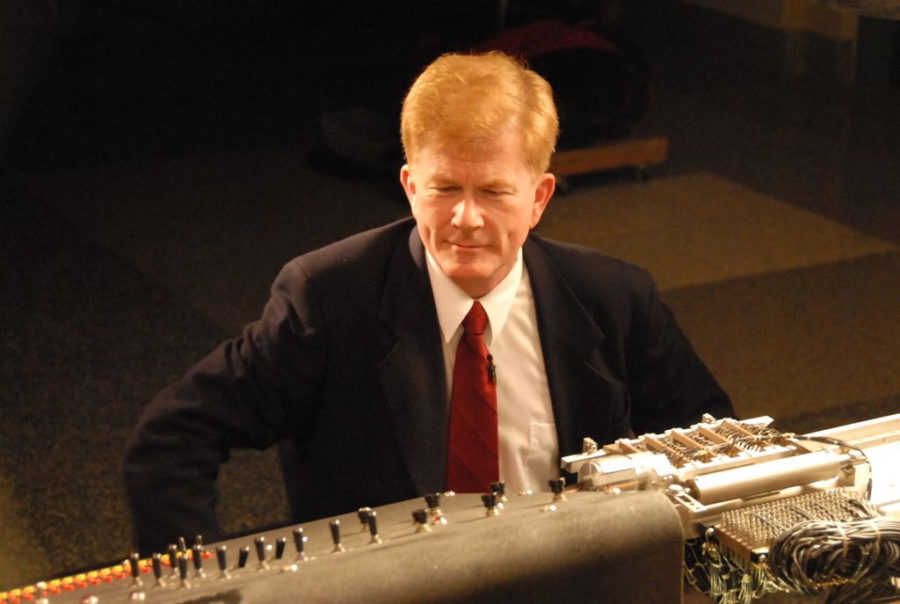JVA Symposium on Modern Computing: Atanasoff-Berry Computer celebrated
Courtesy of John Gustafson, an Iowa State math alumnus, who helped rebuild the Atanasoff-Berry Computer.
The IEEE JVA Symposium on Modern Computing will honor computing pioneer John Vincent Atanasoff (JVA), feature leading global voices in AI and supercomputing and overview the history of computing.
The Atanasoff-Berry Computer, or ABC, was the first electronic digital computer named after and invented by John Vincent Atanasoff, a former professor at Iowa State, and his graduate student assistant Clifford Berry.
The computer was invented in 1939 at Iowa State and introduced the use of binary digits instead of decimal numbers for electronic information retrieval. Known as the Computer Science Building until it was renamed in 1988, Atanasoff Hall at Iowa State is located at 2434 Osborn Dr. According to the history of Iowa State: campus buildings website, the building is named after JVA.
The 120th birthday of Atanasoff will serve as a celebration of the history of computing technology.
According to Daniela Dimitrova, Liberal Arts and Sciences deans’ professor in the Greenlee School of Journalism and Communication and publicity chair of the JVA Symposium, the original ABC was destroyed as it could not be transported out of the Physics Hall basement where Atanasoff and Berry constructed the device.
As the original was destroyed and Atanasoff and Berry moved on to other projects, J. Presper Eckert and John Mauchly developed the ENIAC computer (Electronic Numerical Integrator and Computer) at the University of Pennsylvania and were the initial individuals to obtain a patent for an electronic digital computer, according to the department of electrical and computer engineering website.
Dimitrova said many people began speculating about which computer was really the original electronic digital computer.
“Detractors of JVA’s accomplishments say things like, ‘It never worked perfectly’ and ‘It wasn’t finished’ and try to deny that the ABC should be considered important to the history of computing,” said John Gustafson, an Iowa State math alumnus. “What JVA invented wasn’t so much a computer as it was computing.”
In 1973, U.S. District Judge Earl R. Larson nullified the ENIAC patents, stating that Eckert and Mauchly did not independently invent the automatic electronic digital computer but instead borrowed the idea from Atanasoff.
“Independently, people invented different kinds of computing machines, but the […ABC] was [proven to be] the first digital computer– electronic digital computer,” said Carl K. Chang, professor emeritus of computer science.
A team of engineers, including Gustafson, rebuilt the computer from its original designs in 1997. Gustafson is the plenary keynote speaker at the JVA symposium and will be delivering a speech on ten persistent myths about the ABC.
“The project was led by Del Bluhm and George Strong who used […] original blueprints and the parts lists and everything,” Gustafson said. “We had a few people still alive that we can actually call in who have seen the original, and they just helped to straighten some things out.”
Gustafson said Atanasoff died during the reconstruction process and was not able to see the final project.
“I’m very sorry I never got to meet him in person, but I feel like I know the man,” Gustafson said.
Gustafson said he was eventually put in charge of the project and making the computer function as the project’s leaders were unsuccessful.
“Toward the end of the project, they realized they hadn’t actually made a computer that worked, and at that point, I was put in charge of the project to make it work as a computer,” Gustafson said.
Gustafson said his team struggled to find the readout of the computer, and it turned out to be a small odometer on the device. He added that this information would not have been known unless his team had spoken to some of the original device’s engineers over the phone.
“We also found out from a [retired] secretary at Iowa State […] that the computer had actually gotten considerable production use; it had really done real work on statistics,” Gustafson said.
Gustafson said Eckert and Mauchly of the ENIAC computer stole the concept when people wanted to commercialize the computer.
“You had three companies that came out of it: Sperry, the successors to the ENIAC, and the ABC, which led to both [the Burroughs Corporation] and IBM machines, and so that was the beginning of industrial computing,” Gustafson said.
Gustafson said because his team was able to actually construct the device and were able to see all the knowledge and thinking that went into the building process, it was just a great achievement for 1939.
Gustafson said he believes Atanasoff has been well-recognized for his work and was appreciative of the recognition.
“George H.W. Bush gave the United States National Medal of Technology, the highest scientific recognition of technology, to Atanasoff at the White House awards,” Gustafson said.
Hridesh Rajan, professor and department chair of computer science, said Atanasoff is receiving proper recognition for his work as he is being celebrated by a major symposium within one of the two major computing societies– IEEE (Institute of Electrical and Electronics Engineers).
“Many of the key ideas of modern computing were invented right here, right on this campus, and that, in my mind, is a legacy that we need to celebrate,” Rajan said.
Rajan said Atanasoff is attributed with the invention of not only the electronic digital computer but many of the key ideas in modern computing.
“He came up with a concept of memory in a computer […] and the idea of calculation by binary logic; he came up with the idea of the fully-electronic arithmetic […] and parallel processing,” Rajan said. “His computer, the first digital computer, had 30 modular units that were all working at one time.”
Rajan said Atanasoff also initiated the idea of mass storage and different levels of memory on a computer. Other concepts that originated from Atanasoff include: the global system clock, table ROM, 15-decimal accuracy when solving linear equations and decimal input and output with automatic conversion to binary for internal operations, according to Rajan.
“He came up with a fairly important set of ideas that now form the basis of modern computing as we know it,” Rajan said.
Rajan collaborated with Chang and Vladimir Getov, the general chair of the Atanasoff symposium and professor of distributed and high-performance computing at the University of Westminster, who invited Rajan to help develop the event.
“I agreed immediately, so there wasn’t really a lot of back and forth because this is such an important event for Iowa State and the department of computer science,” Rajan said.
Rajan said faculty representatives, professor Gianfranco Ciardo and Andrew Miner, from the computer science department and professor Ashfaq Khokhar from the department of electrical computer engineering at Iowa State, are also attending and presenting their views on fundamental data structures and how they should evolve in the future.
“Folks from around the nation, around the world, are coming to Chicago to celebrate the JVA legacy, […] and that doesn’t mean we should not promote the JVA legacy more. We should continue to do so,” Rajan said.
Rajan said the symposium will consist of three panels of professionals in the computing field. According to the symposium website, panelists will speak on metaverse services, open source in science and enterprise and the invention of electronic digital computing.
Chang said the story of the Atanasoff Symposium dates back to 2003 when Iowa State’s former president Gregory Geoffrey contacted Chang with an invitation from the president of Bulgaria to visit Atanasoff’s country of origin and attend a celebration of Atanasoff in Sofia, Bulgaria.
In 2003, according to Chang, the 100th birthday celebration of Atanasoff was held at Iowa State where Chang was appointed general chair for the symposium.
“We actually had a very successful symposium to remember Professor Atanasoff for his legacy of the electronic digital computer [which initiated] modern computing,” Chang said.
Chang said last year it came to his attention that over a decade had passed since the first symposium, which led him to begin organizing the second IEEE JVA Symposium. He said this year’s event will differ in size as many more people will be in attendance and involved in the symposium.
“I think computer scientists need to know [the history of JVA] because the basic principles of computers were all included in the invention by Atanasoff,” Chang said.
Chang said the computing landscape today differs significantly compared to 100 years ago, including the speed and complexity of technology today.
“Everything started with the invention,” Chang said. “ Everything seems to continue to be up to our imagination [today], so the sky’s the limit.”
The IEEE John Vincent Atanasoff Symposium on Modern Computing will be held July 5-6 in Chicago.
Your donation will support the student journalists of the Iowa State Daily. Your contribution will allow us to purchase equipment, send our student journalists to conferences and off-set their cost of living so they can continue to do best-in-the-nation work at the Iowa State Daily.











